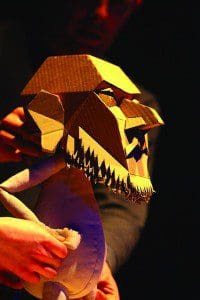
At Blind Summit Theatre’s The Table, showing at Pleasance Dome through August 28 as part of the Edinburgh Fringe Festival, a puppet explains the basic principles of Japanese tabletop puppetry.
Pacing back and forth on the white table serving as his stage — as his entire world—the nameless puppet demonstrates, and everyone can see, how he is operated by three puppeteers—one for head and left hand (Mark Down, who also performs the voice), one for rump and right hand (Sean Garratt), and one for the feet (Nick Barnes). All three are on stage, fully visible, dressed in unassuming black. There are no strings in Bunraku puppetry; the puppeteers’ hands directly control the puppet, in this case a simple white cloth body and cardboard head fashioned to look like an old bearded man with tired eyes (at one point the puppet screams, “I have a backstory! I used to be a box!”). The face doesn’t move: the puppet’s eyes don’t roll back and forth in the manner of marionettes, the mouth doesn’t do that horrible nutcracker thing.
When most of us think of puppetry, we think of Pinocchio or the Muppets—the puppet operated by means of strings or sticks held by unseen hands. The movements are floppy, clumsy, and lifeless—it’s what we expect. To move “like a puppet” (think NSync’s “Bye Bye Bye” video) means to move awkwardly, with a certain uncanny inflexibility. It would be horrible to watch, except we know we’re watching objects and not people.
How strange, then, to experience this form of theater where the puppeteers are fully visible, and yet the illusion is far more complete. It seems strange to talk about the protagonist of The Table without naming him, or to continue to refer to him as “the puppet”—he glides, dances and moves with fluidity, ease and autonomy. The puppeteers are less like people controlling his limbs and more like anxious parents watching a toddler walk along a ledge, there to make sure he doesn’t fall backward. They hover. It’s as if he exists among, not in, their hands.
How’s this illusion accomplished, when one can see Barnes picking up the puppet’s feet to make him walk? As the puppet explains, the trick is “focus.” When the puppeteers look at him, he’s in focus. When they look out at the audience, he goes all blurry. It’s the force of their attention that creates the illusion of aliveness, of almost being alone in the room with that character, and that illusion, though it’s only made of concentration and not of wires and strings and dowels, is more powerful than any I’ve seen in puppet theater.
What’s most wonderful about the Blind Summit performers is the apparent and unquestionable love in their faces when they look on this absurd little cloth man strutting up and down his table. Their expressions capture his emotions, mimicking pride, consternation, grief, astonishment, intent—so much so that after the show we remember seeing the puppet’s face moving, though we know for a certainty that it didn’t.
Most of the audience probably hadn’t given enough thought to Bunraku puppetry to need to have the concept “troubled” for them; a traditional Japanese moralist play with a clear storyline would have been just as enchanting. In The Table, the puppet’s universe is upset by the intrusion of a young (full-size, human) woman who sits down at the table and reads a book. The event is unprecedented; he’s been alone on this table, he tells us, for forty years. Her presence is all the more upsetting because no matter what he does — shouting, leaping on her shoulders and stomping up and down — she doesn’t seem to notice him. He starts out assuming he has an intent and committed audience—after explaining Banraku he declares he will now perform, for us, the last twelve hours of Moses’ life, in real time – only to confront the possibility he doesn’t matter at all, that there may be an entire world beyond the table about which he knows nothing, and which is utterly unconcerned with him.
A show about a puppet having an existential crisis sounds like something people go to so they can feel smug about it. It mightn’t have been moving at all, but for the real and earnest love and attention these artists bestow on their creation. It made me wonder if any actor has ever put that much work and devotion into his Lear or his Timon of Athens. It’s good to know that, at least here in Edinburgh, at least for one crazy month, a sold-out audience gathers in a student union building to worship not cleverness, but craft.

Marianne, what a lovely description. Do continue to have a good time there.